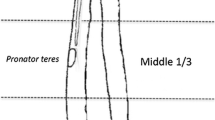Abstract
Background: Pediatric diaphyseal forearm fractures, if considered stable, are usually treated conservatively. Recently, however, there has been a trend towards stabilizing diaphyseal forearm fractures operatively, generally by intramedullary nailing, to avoid angular deformities and functional impairment. The aim of this study was to examine patients with an unsatisfactory outcome after diaphyseal forearm fracture for a possible correlation betwwen their outcome and a remaining axial deviation or a combined angular deformity in order to better ensure that only essential operations are performed.
Patients and Methods: Analysis of 581 pediatric forearm fractures showed a similar distribution concerning age, cause, and fracture site as previously reported in other studies.
Results: 14.8% of our patients showed an unsatisfactory outcome. In some patients, this was due to residual ulnar and plamar angular deformities of the radial shaft. Another reason for a poor outcome was an angular deformity > 15° not depending on the plane the dislocation occurred in; the values, however, were not statistically significant. A discriminating analysis (CART®) of combined mid-diaphyseal fractures with angular deformities of up to 15° demonstrated that the relation of the bony deformities to each other had relevant consequences for the outcome. For example, radiopalmar angular deformities of the radial shaft combined with a nondeformed ulna had a high probability of an unsatisfactory outcome. If this deformity of the radius was combined with a dorsal deformity of the ulnar diaphysis, however, the probability of a satisfactory outcome was high.
Conclusions: In summary, this study indicates that the prognosis of a satisfactory outcome of forearm fractures regarding function and cosmesis is complex and influenced by both the radius and ulna. Diaphyseal angular deformities > 10° should be avoided in the treatment of pediatric forearm fractures.
Similar content being viewed by others
Author information
Authors and Affiliations
Additional information
Received: February 13, 2001; revision accepted: November 7, 2001
Rights and permissions
About this article
Cite this article
Weinberg, AM., Kasten, P., Castellani, C. et al. Which Axial Deviation Results in Limitations of Pro- and Supination Following Diaphyseal Lower Arm Fracture in Childhood?. Eur J Trauma 27, 309–316 (2001). https://doi.org/10.1007/s00068-001-1111-x
Issue Date:
DOI: https://doi.org/10.1007/s00068-001-1111-x




